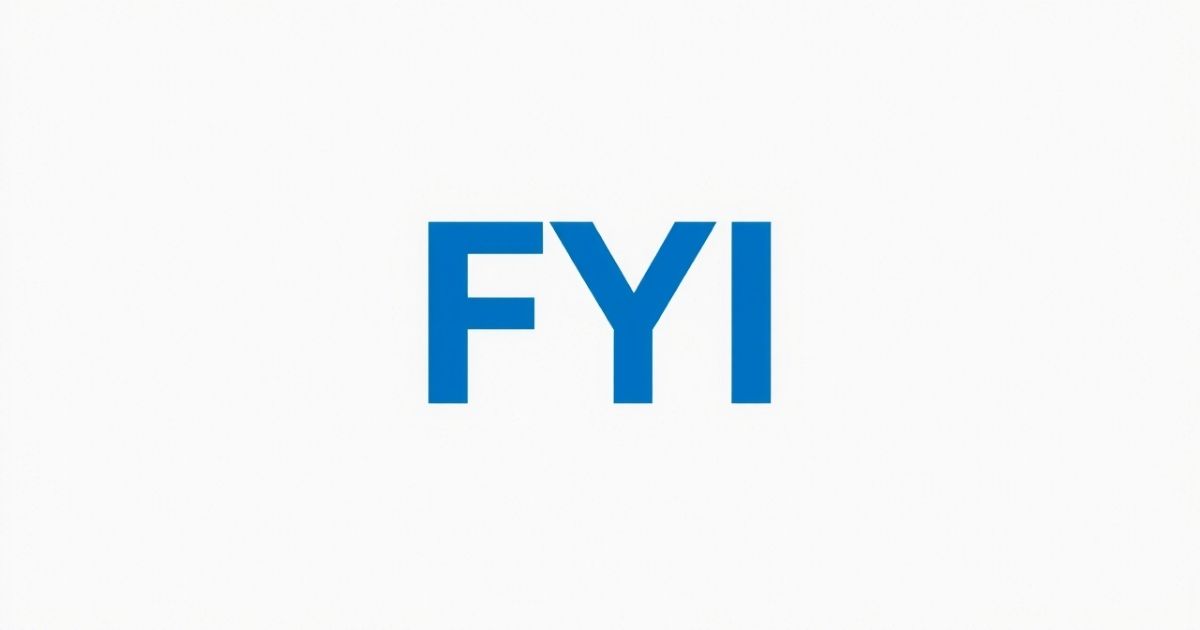Other Ways to Say “FYI” are useful in emails, chats, and workplace updates. Sometimes, saying “FYI” feels too casual or too blunt. You may want to sound more polite or professional. That’s why knowing other ways to say “FYI” matters. These phrases help improve your communication style and tone. If you’re wondering how to professionally say for your information, this guide will help. It shares many options for any situation.
Looking for a good FYI synonym? Want to learn another way to say FYI? You’ll find plenty here. We’ll show you how to say FYI professionally without sounding cold or robotic. This article covers each for your information synonym with examples and tips. Whether it’s a quick note or a formal email, you’ll know what to say. So, if you need help sharing info, try these other ways to say “FYI.”
Main Points
- For Your Information (FYI): A polite and professional way to share important details without requesting action, commonly used in emails, reports, and conversations.
- Heads Up: A casual, proactive phrase used to warn or inform someone about something upcoming, such as a deadline or event. It helps prepare others in advance.
- Note: A concise and polite way to direct attention to important details, often used in formal and informal settings. It’s effective in reports, memos, or messages.
- Quick Note: A short, friendly way to provide information without overwhelming the reader. It’s perfect for quick updates or last-minute details in emails or messages.
- Update: A term used to inform others about changes, progress, or new information. It helps keep everyone aligned, often used in project updates, reports, or status updates.
- Insight: Provides a deeper understanding or perspective, offering more than just facts. It helps guide decision-making and shows expertise.
- FYA (For Your Awareness): A formal version of FYI, ideal for professional or official communications when you want to inform someone without expecting an immediate response.
- In the Loop: Ensures that everyone involved is kept informed and updated. It promotes transparency and helps prevent any one person from feeling left out.
- Sharing Information: Key to building trust and collaboration in teams. It’s essential for organizational efficiency and supports better decision-making.
- Just a Reminder: A polite and effective way to follow up on previous communication, ensuring that important tasks or dates aren’t forgotten without sounding forceful.
For Your Information
For your information is a polite, straightforward way to pass along details without demanding any action. It’s a classic phrase used in workplaces, emails, and formal conversations. This phrase helps you provide key facts, links, or documents that support team cohesion and keep others in the loop. It works especially well when offering a clarification or pointing someone to relevant background materials.
Using your other ways to say “FYI” adds clarity without sounding bossy. It’s useful in reports, memos, and professional emails. If you’re wondering how to professionally say for your information, this phrase remains the gold standard. It signals that you’re offering insight rather than giving an order. It’s also perfect when making a communication tip or offering context. Keep using this for smooth, transparent communication in every message.
Heads Up
Heads up is an informal but powerful phrase. It gives people a quick warning or notice about something coming their way. Whether you’re flagging a change in the project schedule, a system outage, or an approaching deadline, saying heads up gets their attention without sounding harsh. It’s a smart part of everyday internal communication that builds trust and prepares your team.
This other ways to say “FYI” phrase is often seen in chat threads or casual email updates. While it’s not as formal as for your information, it’s very effective. It says, I care enough to warn you in advance. That’s the heart of good workplace communication. So, if you want to give people a little time to adjust or prepare, a quick heads up goes a long way in showing professionalism and kindness.
Note
The word note is short but strong. It gently invites the reader to pay attention to something important. You’ll often find it in documents, reports, or emails when someone wants to highlight a key message or exception. It’s perfect for adding essential info without breaking the flow of the text. For example: Note: The schedule has changed slightly due to updated timelines.
It sounds neutral and respectful, which makes it great for both formal and informal settings. If you’re looking for an other ways to say “FYI” that fits any tone, note is reliable and widely accepted. It reflects solid communication etiquette and supports professional messaging. So next time you want to share a detail without sounding too direct, just say note , it gets the job done.
Quick Note
A quick note is friendly, helpful, and easy to read. It’s a great way to give someone a tiny piece of useful information without overwhelming them. You might use it in an email that says: Quick note: The client call has moved to 3 PM. It shows you value their time and keeps the tone relaxed while still offering important details.
This other ways to say “FYI” phrase is ideal for email updates, reminders, or last-minute points before a meeting. It’s one of the best ways to say FYI professionally while keeping your tone light. People appreciate this simple approach to information sharing, especially in fast-moving projects. So next time you want to alert someone gently, a quick note works like a charm.
Update

An update keeps your team aligned, informed, and productive. Whether it’s a status update, a progress report, or a project update, using this term makes your communication clear and organized. It’s a go-to phrase when sharing changes in plans, team news, or company goals.
Regular updates help support organizational efficiency and show leadership. They reflect transparent communication and show that you value keeping others in the loop. You can say things like: Here’s a quick update on the new rollout timeline. This keeps communication active and improves strategic decision-making. Use it often to share knowledge updates and key progress.
Informative
Calling something informative means it adds value. It’s not just words, it’s content that teaches, explains, or expands your understanding. Whether it’s a report, a guide, or a how-to, being informative shows that you’re serious about sharing information with clarity. It’s a big part of professional communication and makes your content worth reading.
In the workplace, being informative helps teams solve problems faster. Instead of just saying what happened, you explain other ways to say “FYI” the why and how. That builds communication competence and supports smarter, faster work. If you want your messages to land well, make sure they’re not just short, make them informative too.
Related Guide:
FYA (For Your Awareness)
FYA (For Your Awareness) is a more formal way to say FYI, used mostly in emails or official documents. It lets someone know that the information you’re sharing is important, but no response is required. This phrase works best when you’re dealing with formal notifications, policies, or updates that should be read carefully.
It’s especially useful for communication strategies in leadership roles. You might write: FYA: The updated HR policy is attached. It maintains a clear, respectful tone while offering key information. If you’re unsure how to say FYI professionally, FYA is a smart, polished choice. It builds trust and shows respect for the reader’s attention.
In the Loop
Keeping people in the loop is key to building trust and avoiding confusion. It simply means making sure everyone involved knows what’s going on. Whether it’s about deadlines, updates, or changes, this phrase helps ensure transparent communication. You don’t want your coworkers or clients feeling left out. A simple just to keep you in the loop… can go a long way in maintaining team clarity.
In other ways to say “FYI” fast-paced work environments, keeping people in the loop supports team cohesion and strengthens collaboration. It’s also a great way to practice good communication etiquette. People appreciate being included, even if the update doesn’t directly affect them. It shows you’re thinking ahead and respecting others’ roles in the bigger picture. Use it in emails, meetings, or chats whenever you’re providing a relevant status update.
Sharing
Sharing information is a core part of healthy workplace communication. It’s not just about giving facts, it’s about giving the right facts at the right time. When you’re open with updates and details, you create a more trusting and efficient team. Saying I wanted to share this with you sounds helpful and inclusive. It’s one of the easiest ways to improve your communication style.
Good information sharing builds bridges across departments and prevents mistakes. It promotes organizational efficiency, helps with strategic decision-making, and makes your work culture more transparent. Whether you’re sharing information in a report, during a meeting, or through email updates, your goal is to provide value and support the success of others.
Update Alert
An update alert helps you quickly draw attention to something new or different. It shows you care about keeping people informed without making it sound urgent or stressful. It’s often used in the subject lines of internal memos or information bulletins, like Update Alert: New Login Policy in Effect. This grabs attention while maintaining a polite tone.
Including other ways to say “FYI” in your communications shows you value timely reminders and professional messaging. These quick messages are especially helpful when you need to give a critical update without overwhelming the recipient. Use them for schedule changes, new tools, system outages, or anything that affects multiple team members. It’s a key part of proactive internal communication.
Insight
Sharing an insight can change how a team views a problem or project. It offers something deeper than a fact, it shows understanding. This could be a market trend, a customer behavior, or even a new approach to a task. When you say, Here’s an insight that might help, you’re showing leadership and thoughtfulness.
Strong other ways to say “FYI” insights lead to smarter choices and better planning. They support strategic decision-making and help guide teams in the right direction. Insightful communication also shows that you’ve done your homework and want to offer important details. It’s a great way to share ideas while boosting your communication competence.
Just a Reminder

Just a reminder is one of the most polite and effective ways to follow up on tasks or dates. It helps people remember without feeling nagged or pressured. It fits well in emails, chats, or team channels. For example: Just a reminder, the reports are due by noon tomorrow. It’s short, friendly, and useful.
This other ways to say “FYI” phrase keeps your communication style professional and respectful. People are more likely to respond positively when reminders feel kind and considerate. It also shows you’re organized and value team cohesion. Use it for meetings, task deadlines, project updates, or even policy reviews. It’s a small phrase with big results.
Informing
Informing someone means you’re giving them the details they need without asking for anything in return. It’s a formal and respectful way to share updates, especially in professional settings. You might say, I’m informing you of the following changes to the project schedule. This approach keeps things direct while still following good communication etiquette.
In other ways to say “FYI” the workplace, clear information sharing is critical. Informing helps reduce misunderstandings and keeps processes smooth. Whether it’s in a formal notification, email, or bulletin, providing facts clearly shows your commitment to effective communication. It also builds trust, especially when you’re dealing with policies, results, or deadlines.
Something to Know
Sometimes, people just need a heads-up about a small but meaningful detail. That’s where something to know comes in. It’s soft, friendly, and invites attention without pressure. You might say, Something to know, the meeting room changed to B4. It feels helpful instead of commanding.
Using something to know helps improve communication etiquette, especially when you’re not sure how formal the situation should be. It also adds a human touch to your emails and chats. This simple other ways to say “FYI” phrase keeps your messaging strategy warm, effective, and easy to understand. Great for both formal and casual conversations.
FAQ’s
What are some Other Ways to Say “FYI” in emails?
Try phrases like just a reminder, quick note, or for your awareness to sound clear and polite in messages.
How can I use Other Ways to Say “FYI” professionally?
Use formal phrases like please note, for your information, or advance notice to keep your tone respectful and clear in work emails.
Why should I learn Other Ways to Say “FYI”?
Using different terms improves communication, helps you sound professional, and keeps your message friendly and polite in any situation.
Are there polite Other Ways to Say “FYI” for teams?
Yes, try phrases like heads up, team update, or just a reminder to keep things casual yet respectful in group chats or updates.
What’s the best time to use Other Ways to Say “FYI”?
Use them when sharing helpful info, updates, or reminders to ensure better understanding and improve workplace communication.
Conclusion
There are many other ways to say “FYI” that sound more friendly or professional. Using phrases like just a reminder, quick note, or for your awareness (FYA) helps improve your tone. If you’ve ever wondered how to professionally say for your information, now you have better options. Choosing the right FYI synonym shows strong communication competence and good manners. It also builds better team cohesion and creates a more collaborative environment at work.
Always keep your readers in the loop. Use email updates, project schedule notes, or friendly reminders to share important details. These small changes boost workplace communication and help with strategic decision-making. Next time you write a formal notification, use a clear communication tip. Choose essential info that supports transparent communication. Strong information sharing creates real organizational efficiency. With so many great other ways to say “FYI”, you can master professional messaging every time.

Ember Rose is a dedicated administrator with 4 years of experience in efficient operations management and team leadership. Skilled in streamlining workflows and enhancing productivity.

